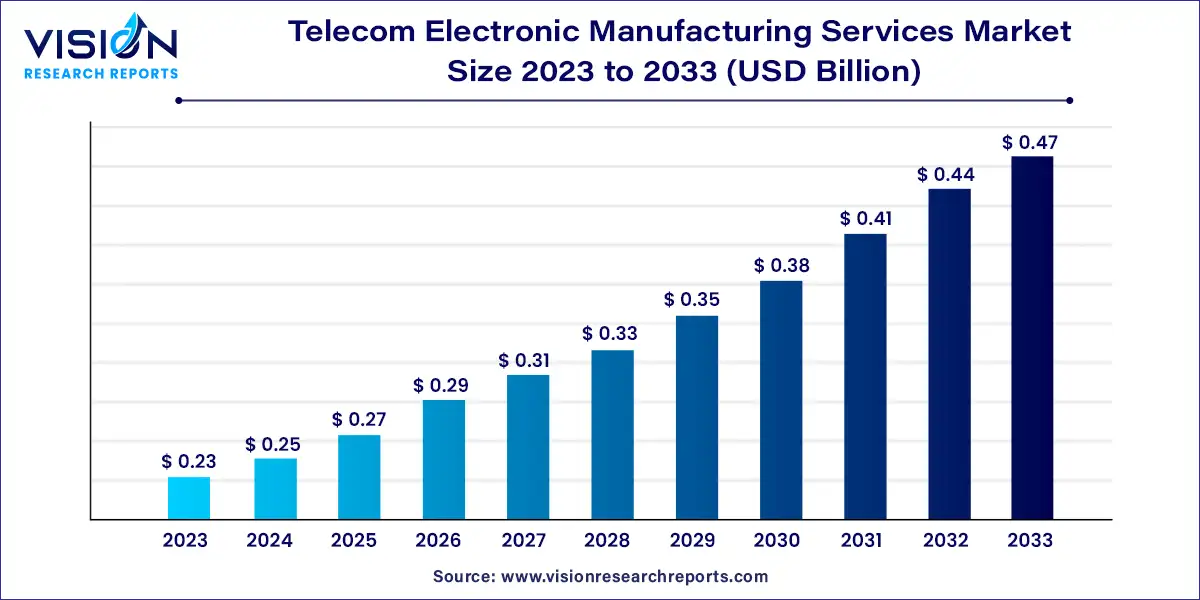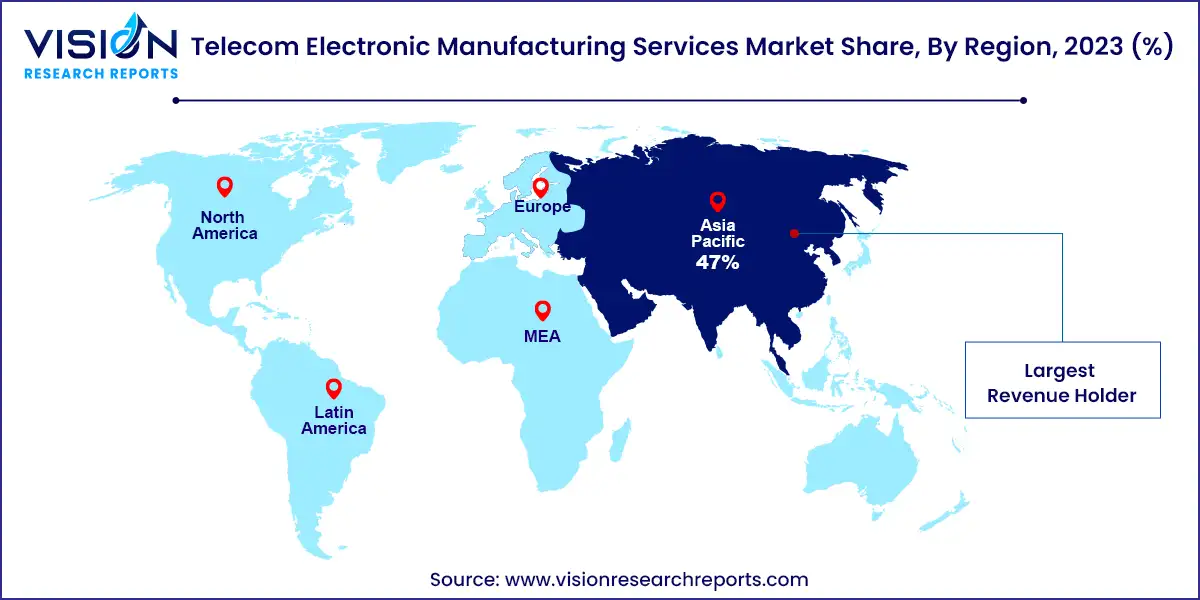The global telecom electronic manufacturing services market size was valued at USD 0.23 billion in 2023 and is anticipated to reach around USD 0.47 billion by 2033, growing at a CAGR of 7.44% from 2024 to 2033.

The growth of the telecom electronic manufacturing services (EMS) market is driven by an increasing demand for advanced telecommunications infrastructure globally, coupled with rapid technological advancements, fuels the need for efficient EMS solutions. Secondly, outsourcing manufacturing to specialized EMS providers enables telecom companies to focus on core competencies, enhancing operational efficiency and reducing time-to-market for new products. Thirdly, the rise in consumer demand for high-speed internet, mobile connectivity, and IoT applications necessitates agile and scalable manufacturing solutions provided by EMS firms. These factors collectively contribute to the robust expansion of the Telecom EMS market, positioning it as a critical enabler of innovation and competitiveness within the telecom industry.
In 2023, the electronic manufacturing segment claimed the largest revenue share at 45%. Original Equipment Manufacturers (OEMs) are increasingly outsourcing product design and development to subcontractors to achieve two primary benefits: shifting from fixed to variable costs and reducing overall expenses. Many telecommunications electronic contract manufacturers are expanding their service offerings with higher profit margins, a move expected to drive segment growth in the coming years.
The electronic design and engineering segment is projected to grow at a rapid CAGR of 9.33% during the forecast period. Advancements in wireless communication sensor technologies and big data capabilities are facilitating the transformation of IoT, influencing product engineering and design processes to meet escalating consumer expectations and requirements. This trend is anticipated to significantly contribute to the segment's expansion.
Asia Pacific led the market, capturing the largest revenue share of 47% in 2023, and is forecasted to grow at the fastest CAGR of 7.9% over the forecast period. OEMs in the region are increasingly outsourcing product design processes, allowing them to concentrate on core competencies. Asia Pacific has maintained its position as a vital electronic production hub for nearly a decade due to low labor costs, significantly bolstering its dominance in recent years.

However, rising labor costs in countries like China and other Southeast Asian nations have prompted efforts to position themselves as manufacturers of complex products. For example, Vietnam is emerging as a key hub for electronics component production, supported by investments from major players such as Samsung Electronics and LG Electronics. These developments are expected to further enhance the region's market.
North America is expected to experience substantial growth during the forecast period, driven by the proliferation of smart devices and increasing demand for environmentally friendly component manufacturing. Additionally, the thriving telecom industry in the region is poised to bolster market growth significantly.
By Service
By Region
Chapter 1. Introduction
1.1. Research Objective
1.2. Scope of the Study
1.3. Definition
Chapter 2. Research Methodology
2.1. Research Approach
2.2. Data Sources
2.3. Assumptions & Limitations
Chapter 3. Executive Summary
3.1. Market Snapshot
Chapter 4. Market Variables and Scope
4.1. Introduction
4.2. Market Classification and Scope
4.3. Industry Value Chain Analysis
4.3.1. Raw Material Procurement Analysis
4.3.2. Sales and Distribution Channel Analysis
4.3.3. Downstream Buyer Analysis
Chapter 5. COVID 19 Impact on Telecom Electronic Manufacturing Services Market
5.1. COVID-19 Landscape: Telecom Electronic Manufacturing Services Industry Impact
5.2. COVID 19 - Impact Assessment for the Industry
5.3. COVID 19 Impact: Global Major Government Policy
5.4. Market Trends and Opportunities in the COVID-19 Landscape
Chapter 6. Market Dynamics Analysis and Trends
6.1. Market Dynamics
6.1.1. Market Drivers
6.1.2. Market Restraints
6.1.3. Market Opportunities
6.2. Porter’s Five Forces Analysis
6.2.1. Bargaining power of suppliers
6.2.2. Bargaining power of buyers
6.2.3. Threat of substitute
6.2.4. Threat of new entrants
6.2.5. Degree of competition
Chapter 7. Competitive Landscape
7.1.1. Company Market Share/Positioning Analysis
7.1.2. Key Strategies Adopted by Players
7.1.3. Vendor Landscape
7.1.3.1. List of Suppliers
7.1.3.2. List of Buyers
Chapter 8. Global Telecom Electronic Manufacturing Services Market, By Service
8.1. Telecom Electronic Manufacturing Services Market, by Service Type, 2024-2033
8.1.1. Electronic Design & Engineering
8.1.1.1. Market Revenue and Forecast (2021-2033)
8.1.2. Electronics Assembly
8.1.2.1. Market Revenue and Forecast (2021-2033)
8.1.3. Electronic Manufacturing
8.1.3.1. Market Revenue and Forecast (2021-2033)
8.1.4. Supply Chain Management
8.1.4.1. Market Revenue and Forecast (2021-2033)
8.1.5. Others
8.1.5.1. Market Revenue and Forecast (2021-2033)
Chapter 9. Global Telecom Electronic Manufacturing Services Market, Regional Estimates and Trend Forecast
9.1. North America
9.1.1. Market Revenue and Forecast, by Service (2021-2033)
9.1.2. U.S.
9.1.2.1. Market Revenue and Forecast, by Service (2021-2033)
9.1.3. Rest of North America
9.1.3.1. Market Revenue and Forecast, by Service (2021-2033)
9.2. Europe
9.2.1. Market Revenue and Forecast, by Service (2021-2033)
9.2.2. UK
9.2.2.1. Market Revenue and Forecast, by Service (2021-2033)
9.2.3. Germany
9.2.3.1. Market Revenue and Forecast, by Service (2021-2033)
9.2.4. France
9.2.4.1. Market Revenue and Forecast, by Service (2021-2033)
9.2.5. Rest of Europe
9.2.5.1. Market Revenue and Forecast, by Service (2021-2033)
9.3. APAC
9.3.1. Market Revenue and Forecast, by Service (2021-2033)
9.3.2. India
9.3.2.1. Market Revenue and Forecast, by Service (2021-2033)
9.3.3. China
9.3.3.1. Market Revenue and Forecast, by Service (2021-2033)
9.3.4. Japan
9.3.4.1. Market Revenue and Forecast, by Service (2021-2033)
9.3.5. Rest of APAC
9.3.5.1. Market Revenue and Forecast, by Service (2021-2033)
9.4. MEA
9.4.1. Market Revenue and Forecast, by Service (2021-2033)
9.4.2. GCC
9.4.2.1. Market Revenue and Forecast, by Service (2021-2033)
9.4.3. North Africa
9.4.3.1. Market Revenue and Forecast, by Service (2021-2033)
9.4.4. South Africa
9.4.4.1. Market Revenue and Forecast, by Service (2021-2033)
9.4.5. Rest of MEA
9.4.5.1. Market Revenue and Forecast, by Service (2021-2033)
9.5. Latin America
9.5.1. Market Revenue and Forecast, by Service (2021-2033)
9.5.2. Brazil
9.5.2.1. Market Revenue and Forecast, by Service (2021-2033)
9.5.3. Rest of LATAM
9.5.3.1. Market Revenue and Forecast, by Service (2021-2033)
Chapter 10. Company Profiles
10.1. FLEX LTD.
10.1.1. Company Overview
10.1.2. Product Offerings
10.1.3. Financial Performance
10.1.4. Recent Initiatives
10.2. Jabil Inc.
10.2.1. Company Overview
10.2.2. Product Offerings
10.2.3. Financial Performance
10.2.4. Recent Initiatives
10.3. Plexus Corp.
10.3.1. Company Overview
10.3.2. Product Offerings
10.3.3. Financial Performance
10.3.4. Recent Initiatives
10.4. Benchmark Electronics, Inc.
10.4.1. Company Overview
10.4.2. Product Offerings
10.4.3. Financial Performance
10.4.4. Recent Initiatives
10.5. Celestica Inc.
10.5.1. Company Overview
10.5.2. Product Offerings
10.5.3. Financial Performance
10.5.4. Recent Initiatives
10.6. COMPAL Inc.
10.6.1. Company Overview
10.6.2. Product Offerings
10.6.3. Financial Performance
10.6.4. Recent Initiatives
10.7. Creation Technologies LP
10.7.1. Company Overview
10.7.2. Product Offerings
10.7.3. Financial Performance
10.7.4. Recent Initiatives
10.8. Fabrinet
10.8.1. Company Overview
10.8.2. Product Offerings
10.8.3. Financial Performance
10.8.4. Recent Initiatives
10.9. Foxconn Technology
10.9.1. Company Overview
10.9.2. Product Offerings
10.9.3. Financial Performance
10.9.4. Recent Initiatives
10.10. Sanmina Corporation
10.10.1. Company Overview
10.10.2. Product Offerings
10.10.3. Financial Performance
10.10.4. Recent Initiatives
Chapter 11. Research Methodology
11.1. Primary Research
11.2. Secondary Research
11.3. Assumptions
Chapter 12. Appendix
12.1. About Us
12.2. Glossary of Terms
 Cross-segment Market Size and Analysis for
Mentioned Segments
Cross-segment Market Size and Analysis for
Mentioned Segments
 Additional Company Profiles (Upto 5 With No Cost)
Additional Company Profiles (Upto 5 With No Cost)
 Additional Countries (Apart From Mentioned Countries)
Additional Countries (Apart From Mentioned Countries)
 Country/Region-specific Report
Country/Region-specific Report
 Go To Market Strategy
Go To Market Strategy
 Region Specific Market Dynamics
Region Specific Market Dynamics Region Level Market Share
Region Level Market Share Import Export Analysis
Import Export Analysis Production Analysis
Production Analysis Others
Others